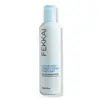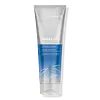What's inside
What's inside
 Key Ingredients
Key Ingredients

No key ingredients
 Benefits
Benefits

 Concerns
Concerns

 Ingredients Side-by-side
Ingredients Side-by-side

Water
Skin ConditioningCetearyl Alcohol
EmollientPropanediol
SolventSorbitol
HumectantCetyl Alcohol
EmollientBehentrimonium Chloride
PreservativeQuaternium-91
Dimethicone
EmollientGlyceryl Oleate
EmollientGlycerin
HumectantPEG-4 Laurate
EmulsifyingBrassica Campestris Seed Oil
Skin ConditioningSesamum Indicum Seed Oil
EmollientHelianthus Annuus Seed Oil
EmollientParfum
MaskingTocopherol
AntioxidantEmblica Officinalis Fruit Extract
Skin ConditioningButylene Glycol
HumectantPCA Dimethicone
Skin ConditioningAminomethyl Propanol
BufferingDisodium PEG-12 Dimethicone Sulfosuccinate
CleansingPPG-3 Benzyl Ether Myristate
EmollientSteartrimonium Chloride
PreservativeIsopropyl Alcohol
SolventPolyquaternium-37
Polyquaternium-73
Propylene Glycol Dicaprylate/Dicaprate
EmollientCitric Acid
BufferingEthylhexylglycerin
Skin ConditioningPPG-1 Trideceth-6
Skin ConditioningPEG-90m
Emulsion StabilisingAcrylates/Stearyl Methacrylate Copolymer
Emulsion StabilisingOctyldodecyl Ricinoleate
EmollientSorbitan Oleate
EmulsifyingCetyl Esters
EmollientPotassium Sorbate
PreservativeSodium Benzoate
MaskingPentasodium Pentetate
Phenoxyethanol
PreservativeTetrasodium EDTA
Coumarin
PerfumingWater, Cetearyl Alcohol, Propanediol, Sorbitol, Cetyl Alcohol, Behentrimonium Chloride, Quaternium-91, Dimethicone, Glyceryl Oleate, Glycerin, PEG-4 Laurate, Brassica Campestris Seed Oil, Sesamum Indicum Seed Oil, Helianthus Annuus Seed Oil, Parfum, Tocopherol, Emblica Officinalis Fruit Extract, Butylene Glycol, PCA Dimethicone, Aminomethyl Propanol, Disodium PEG-12 Dimethicone Sulfosuccinate, PPG-3 Benzyl Ether Myristate, Steartrimonium Chloride, Isopropyl Alcohol, Polyquaternium-37, Polyquaternium-73, Propylene Glycol Dicaprylate/Dicaprate, Citric Acid, Ethylhexylglycerin, PPG-1 Trideceth-6, PEG-90m, Acrylates/Stearyl Methacrylate Copolymer, Octyldodecyl Ricinoleate, Sorbitan Oleate, Cetyl Esters, Potassium Sorbate, Sodium Benzoate, Pentasodium Pentetate, Phenoxyethanol, Tetrasodium EDTA, Coumarin
Water
Skin ConditioningButylene Glycol
HumectantDimethicone
EmollientSorbitol
HumectantBehenyl Alcohol
EmollientStearyl Alcohol
EmollientBehentrimonium Chloride
PreservativeCetyl Alcohol
EmollientGlyceryl Oleate
EmollientParfum
MaskingPhenoxyethanol
PreservativeLaurdimonium Hydroxypropyl Hydrolyzed Keratin
Skin ConditioningArginine Hcl
Skin ConditioningRosa Canina Fruit Oil
EmollientSimmondsia Chinensis Seed Oil
EmollientButyrospermum Parkii Butter
Skin ConditioningOlea Europaea Fruit Oil
MaskingHydrogenated Vegetable Oil
EmollientAstrocaryum Murumuru Seed Butter
EmollientHydrolyzed Algin
Sea Water
HumectantChlorella Vulgaris Extract
Skin ConditioningPhosphatidylcholine
EmulsifyingAminopropyl Dimethicone
Glutamic Acid
HumectantStearyl Dihydroxypropyldimonium Oligosaccharides
PEG-90m
Emulsion StabilisingOctyldodecanol
EmollientSteartrimonium Chloride
PreservativePEG-6 Methyl Ether Dimethicone
EmulsifyingGlycerin
HumectantPropylene Glycol
HumectantPEG-4 Laurate
EmulsifyingTetrasodium Glutamate Diacetate
Isopropyl Alcohol
SolventSodium Hydroxide
BufferingIodopropynyl Butylcarbamate
PreservativeCitric Acid
BufferingLimonene
PerfumingBenzyl Benzoate
AntimicrobialCI 15510
Cosmetic ColorantCI 19140
Cosmetic ColorantWater, Butylene Glycol, Dimethicone, Sorbitol, Behenyl Alcohol, Stearyl Alcohol, Behentrimonium Chloride, Cetyl Alcohol, Glyceryl Oleate, Parfum, Phenoxyethanol, Laurdimonium Hydroxypropyl Hydrolyzed Keratin, Arginine Hcl, Rosa Canina Fruit Oil, Simmondsia Chinensis Seed Oil, Butyrospermum Parkii Butter, Olea Europaea Fruit Oil, Hydrogenated Vegetable Oil, Astrocaryum Murumuru Seed Butter, Hydrolyzed Algin, Sea Water, Chlorella Vulgaris Extract, Phosphatidylcholine, Aminopropyl Dimethicone, Glutamic Acid, Stearyl Dihydroxypropyldimonium Oligosaccharides, PEG-90m, Octyldodecanol, Steartrimonium Chloride, PEG-6 Methyl Ether Dimethicone, Glycerin, Propylene Glycol, PEG-4 Laurate, Tetrasodium Glutamate Diacetate, Isopropyl Alcohol, Sodium Hydroxide, Iodopropynyl Butylcarbamate, Citric Acid, Limonene, Benzyl Benzoate, CI 15510, CI 19140
Ingredients Explained
These ingredients are found in both products.
Ingredients higher up in an ingredient list are typically present in a larger amount.
This ingredient is a preservative and often used for it's anti-static properties. You'll most likely see this ingredient in hair conditioners.
It does not cause irritation or sensitization in leave-on products at 1-5%.
Butylene Glycol (or BG) is used within cosmetic products for a few different reasons:
Overall, Butylene Glycol is a safe and well-rounded ingredient that works well with other ingredients.
Though this ingredient works well with most skin types, some people with sensitive skin may experience a reaction such as allergic rashes, closed comedones, or itchiness.
Learn more about Butylene GlycolCetyl Alcohol is a fatty alcohol. Fatty Alcohols are most often used as an emollient or to thicken a product.
Its main roles are:
Though it has "alcohol" in the name, it is not related to denatured alcohol or ethyl alcohol.
The FDA allows products labeled "alcohol-free" to have fatty alcohols.
Learn more about Cetyl AlcoholCitric Acid is an alpha hydroxy acid (AHA) naturally found in citrus fruits like oranges, lemons, and limes.
Like other AHAs, citric acid can exfoliate skin by breaking down the bonds that hold dead skin cells together. This helps reveal smoother and brighter skin underneath.
However, this exfoliating effect only happens at high concentrations (20%) which can be hard to find in cosmetic products.
Due to this, citric acid is usually included in small amounts as a pH adjuster. This helps keep products slightly more acidic and compatible with skin's natural pH.
In skincare formulas, citric acid can:
While it can provide some skin benefits, research shows lactic acid and glycolic acid are generally more effective and less irritating exfoliants.
Most citric acid used in skincare today is made by fermenting sugars (usually from molasses). This synthetic version is identical to the natural citrus form but easier to stabilize and use in formulations.
Read more about some other popular AHA's here:
Learn more about Citric AcidDimethicone is a type of synthetic silicone created from natural materials such as quartz.
What it does:
Dimethicone comes in different viscosities:
Depending on the viscosity, dimethicone has different properties.
Ingredients lists don't always show which type is used, so we recommend reaching out to the brand if you have questions about the viscosity.
This ingredient is unlikely to cause irritation because it does not get absorbed into skin. However, people with silicone allergies should be careful about using this ingredient.
Note: Dimethicone may contribute to pilling. This is because it is not oil or water soluble, so pilling may occur when layered with products. When mixed with heavy oils in a formula, the outcome is also quite greasy.
Learn more about DimethiconeGlycerin is already naturally found in your skin. It helps moisturize and protect your skin.
A study from 2016 found glycerin to be more effective as a humectant than AHAs and hyaluronic acid.
As a humectant, it helps the skin stay hydrated by pulling moisture to your skin. The low molecular weight of glycerin allows it to pull moisture into the deeper layers of your skin.
Hydrated skin improves your skin barrier; Your skin barrier helps protect against irritants and bacteria.
Glycerin has also been found to have antimicrobial and antiviral properties. Due to these properties, glycerin is often used in wound and burn treatments.
In cosmetics, glycerin is usually derived from plants such as soybean or palm. However, it can also be sourced from animals, such as tallow or animal fat.
This ingredient is organic, colorless, odorless, and non-toxic.
Glycerin is the name for this ingredient in American English. British English uses Glycerol/Glycerine.
Learn more about GlycerinGlyceryl Oleate is the ester of glycerin and oleic acid. This ingredient is mainly an emollient and emulsifier.
Emollients soften and hydrate the skin by creating a thin film on top to trap in moisture. As an emulsifier, glyceryl oleate helps stabilize formulations by preventing ingredients such as oil and water from separating. According to a manufacturer, this ingredient helps helps thicken water-in-oil formulations, shower gels, and hair shampoos.
In some products, this ingredient may be used as a fragrance / perfuming ingredient. The scent of this ingredient is described to be "waxy".
Glyceryl oleate is created from oils rich in oleic acid, such as peanut oil and olive oil.
This ingredient may not be malassezia folliculitis safe.
Learn more about Glyceryl OleateIsopropyl Alcohol is more commonly known as rubbing alcohol. It is most commonly used as a solvent, meaning it helps other ingredients dissolve.
This ingredient is an astringent alcohol. Astringent alcohols may also irritate skin as they high amounts may strip away your skin's natural oils.
Other types of astringent alcohols include:
According to the National Rosacea Society based in the US, you should be mindful of products with these alcohols in the top half of ingredients.
Any type of sanitizing product will have high amounts of alcohol to help kill bacteria and viruses.
Learn more about Isopropyl AlcoholParfum is a catch-all term for an ingredient or more that is used to give a scent to products.
Also called "fragrance", this ingredient can be a blend of hundreds of chemicals or plant oils. This means every product with "fragrance" or "parfum" in the ingredients list is a different mixture.
For instance, Habanolide is a proprietary trade name for a specific aroma chemical. When used as a fragrance ingredient in cosmetics, most aroma chemicals fall under the broad labeling category of “FRAGRANCE” or “PARFUM” according to EU and US regulations.
The term 'parfum' or 'fragrance' is not regulated in many countries. In many cases, it is up to the brand to define this term.
For instance, many brands choose to label themselves as "fragrance-free" because they are not using synthetic fragrances. However, their products may still contain ingredients such as essential oils that are considered a fragrance by INCI standards.
One example is Calendula flower extract. Calendula is an essential oil that still imparts a scent or 'fragrance'.
Depending on the blend, the ingredients in the mixture can cause allergies and sensitivities on the skin. Some ingredients that are known EU allergens include linalool and citronellol.
Parfum can also be used to mask or cover an unpleasant scent.
The bottom line is: not all fragrances/parfum/ingredients are created equally. If you are worried about fragrances, we recommend taking a closer look at an ingredient. And of course, we always recommend speaking with a professional.
Learn more about ParfumPEG-4 Laurate isn't fungal acne safe.
We don't have a description for PEG-90m yet.
Phenoxyethanol is a preservative that has germicide, antimicrobial, and aromatic properties. Studies show that phenoxyethanol can prevent microbial growth. By itself, it has a scent that is similar to that of a rose.
It's often used in formulations along with Caprylyl Glycol to preserve the shelf life of products.
Sorbitol is a sugar alcohol. It is a hydrating and moisturizing agent created from the reduction process of glucose.
Most sorbitol is usually made from potato starch. It is also found in fruits such as apples and pears.
As a humectant, Sorbitol helps draw water to the skin. This helps keep the skin hydrated. Sorbitol also helps create a thicker texture in products. You might find sorbitol in your toothpaste and other gels.
It is a non-irritating ingredient that is great for those with dry skin.
Sorbitol is a prebiotic. It helps promote the growth of healthy bacteria on your skin. The bacteria on your skin form a microbiome. This microbiome helps protect your skin from infection and harmful bacteria.
Learn more about SorbitolSteartrimonium Chloride is a preservative.
Water. It's the most common cosmetic ingredient of all. You'll usually see it at the top of ingredient lists, meaning that it makes up the largest part of the product.
So why is it so popular? Water most often acts as a solvent - this means that it helps dissolve other ingredients into the formulation.
You'll also recognize water as that liquid we all need to stay alive. If you see this, drink a glass of water. Stay hydrated!
Learn more about Water